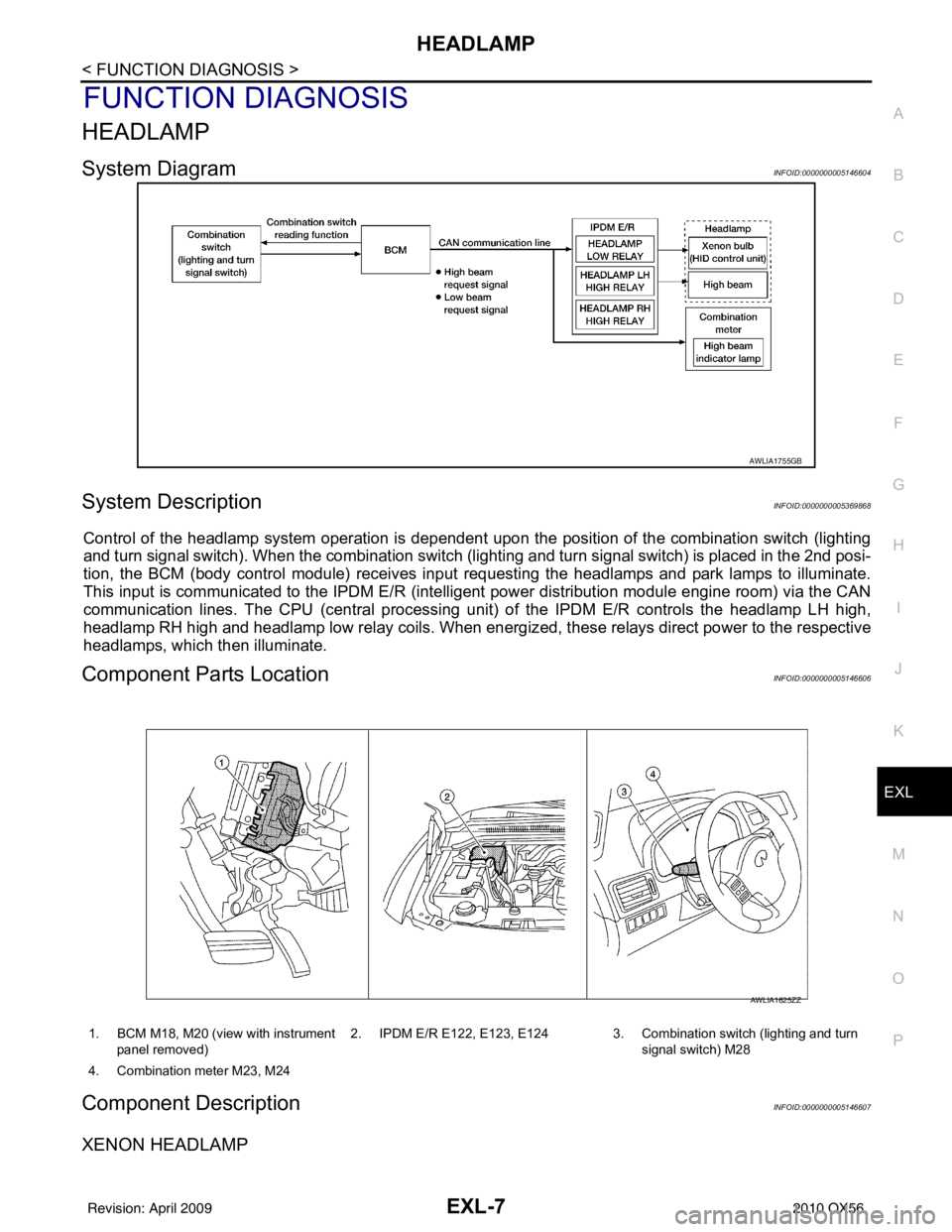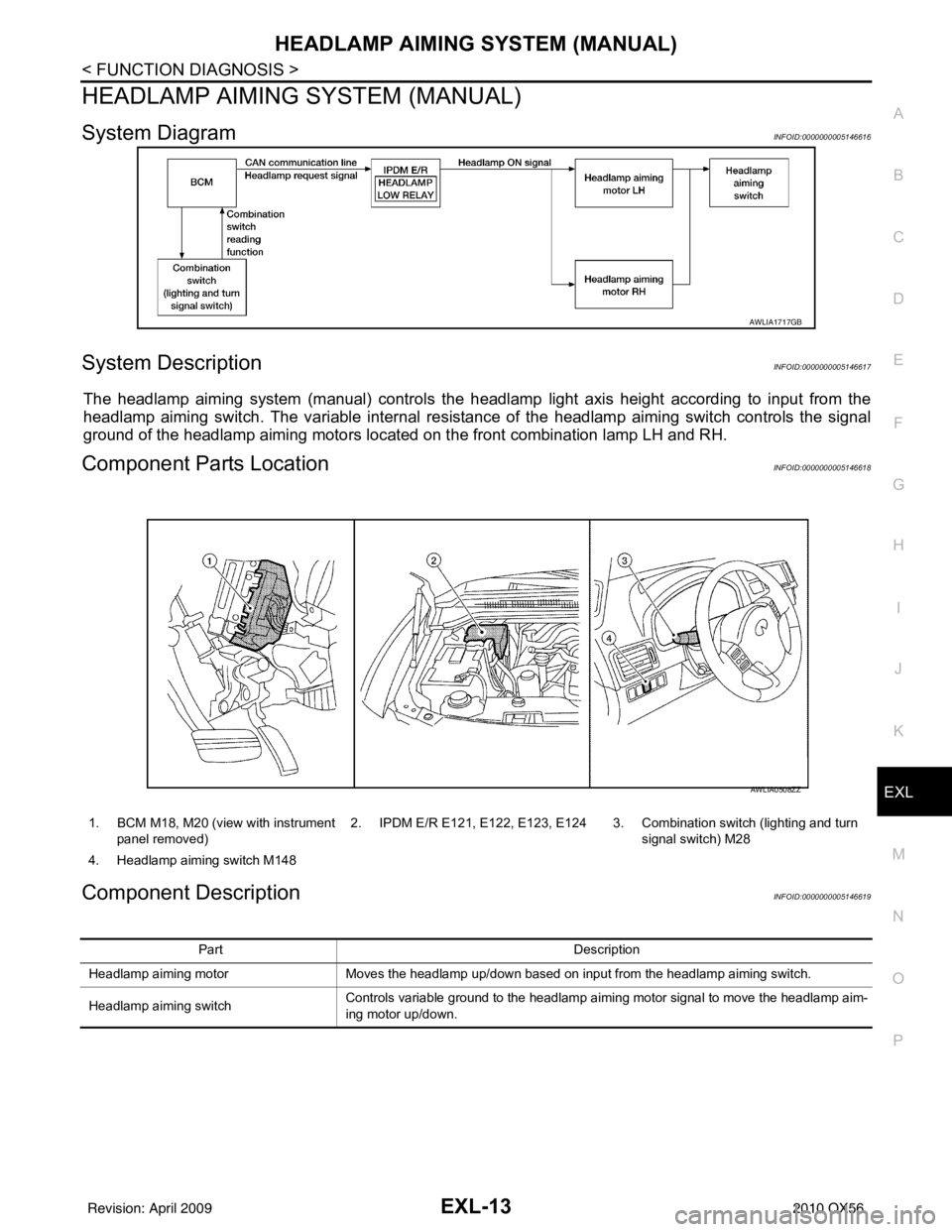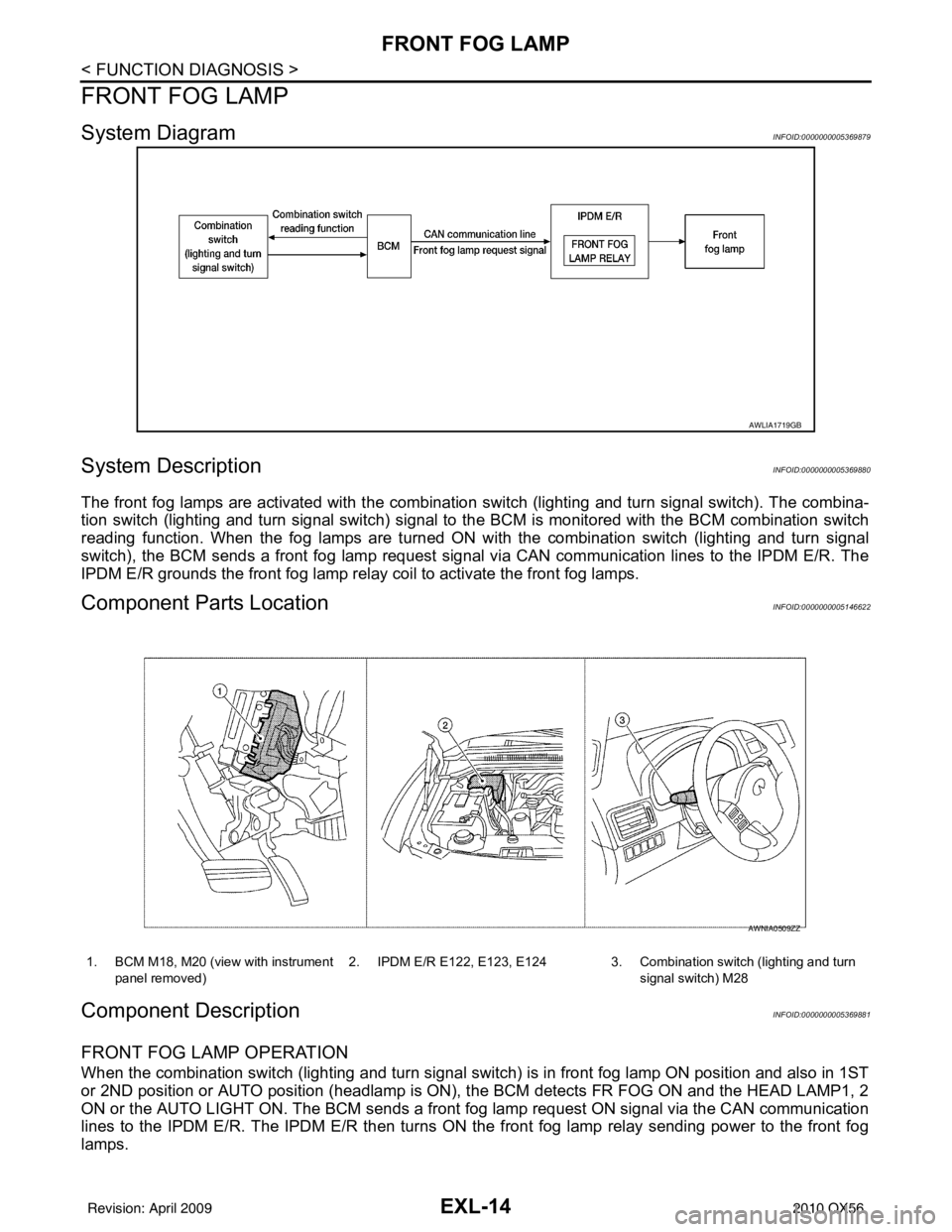2010 INFINITI QX56 instrument panel
[x] Cancel search: instrument panelPage 1212 of 4210
![INFINITI QX56 2010 Factory Service Manual DLN-130
< ON-VEHICLE REPAIR >[ATX14B]
TRANSFER CONTROL UNIT
ON-VEHICLE REPAIR
TRANSFER CONTROL UNIT
Removal and InstallationINFOID:0000000005148887
REMOVAL
1. Set transfer state as 2WD when 4WD shift INFINITI QX56 2010 Factory Service Manual DLN-130
< ON-VEHICLE REPAIR >[ATX14B]
TRANSFER CONTROL UNIT
ON-VEHICLE REPAIR
TRANSFER CONTROL UNIT
Removal and InstallationINFOID:0000000005148887
REMOVAL
1. Set transfer state as 2WD when 4WD shift](/manual-img/42/57032/w960_57032-1211.png)
DLN-130
< ON-VEHICLE REPAIR >[ATX14B]
TRANSFER CONTROL UNIT
ON-VEHICLE REPAIR
TRANSFER CONTROL UNIT
Removal and InstallationINFOID:0000000005148887
REMOVAL
1. Set transfer state as 2WD when 4WD shift switch is at 2WD, or as AUTO when 4WD shift switch is at
AUTO.
CAUTION:
When removing transfer co ntrol unit, transfer state must be at 2WD or AUTO.
2. Turn the ignition switch OFF and disconnect negative battery terminal.
3. Remove the lower instrument panel RH. Refer to IP-17, "
Exploded View".
4. Disconnect the two transfer control unit connectors.
5. Remove the transfer control unit bolts.
6. Remove the transfer control unit.
INSTALLATION
Installation is in the reverse order of removal.
• When installing the transfer control unit, tighten bolts to the specified torque.
CAUTION:
Do not connect harness connector to transfer control unit when 4WD shift switch is at 4LO.
• After the installation, check perform self-diagnosis. Refer to DLN-6, "
Work Flow". If NG, adjust position
between transfer assembly and transfer control unit. Refer to DLN-121, "
Precaution for Transfer Assembly
and Transfer Control Unit Replacement".
BDIA0014E
Transfer control unit bolts : 3.4 N·m (0.35 kg-m, 30 in-lb)
Revision: April 20092010 QX56
Page 1394 of 4210
![INFINITI QX56 2010 Factory Service Manual ON BOARD DIAGNOSTIC (OBD) SYSTEMEC-41
< FUNCTION DIAGNOSIS > [VK56DE]
C
D
E
F
G H
I
J
K L
M A
EC
NP
O
ON BOARD DIAGNOSTIC (OBD) SYSTEM
IntroductionINFOID:0000000005149074
The ECM has an on board diagn INFINITI QX56 2010 Factory Service Manual ON BOARD DIAGNOSTIC (OBD) SYSTEMEC-41
< FUNCTION DIAGNOSIS > [VK56DE]
C
D
E
F
G H
I
J
K L
M A
EC
NP
O
ON BOARD DIAGNOSTIC (OBD) SYSTEM
IntroductionINFOID:0000000005149074
The ECM has an on board diagn](/manual-img/42/57032/w960_57032-1393.png)
ON BOARD DIAGNOSTIC (OBD) SYSTEMEC-41
< FUNCTION DIAGNOSIS > [VK56DE]
C
D
E
F
G H
I
J
K L
M A
EC
NP
O
ON BOARD DIAGNOSTIC (OBD) SYSTEM
IntroductionINFOID:0000000005149074
The ECM has an on board diagnostic system, which detects malfunctions related to engine sensors or actua-
tors. The ECM also records various emission-related diagnostic information including:
The above information can be checked using procedures listed in the table below.
×
: Applicable —: Not applicable
*: When DTC and 1st trip DTC simultaneously appear on the display, they cannot be clearly distinguished from each other.
The malfunction indicator lamp (MIL) on the instrument panel lights up when the same malfunction is detected
in two consecutive trips (Two trip detection logic) , or when the ECM enters fail-safe mode. (Refer to EC-456,
"Fail-Safe Chart".)
Two Trip Detection LogicINFOID:0000000005149075
When a malfunction is detected for the first time, 1st tr ip DTC and 1st trip Freeze Frame data are stored in the
ECM memory. The MIL will not light up at this stage. <1st trip>
If the same malfunction is detected again during the next drive, the DTC and Freeze Frame data are stored in
the ECM memory, and the MIL lights up. The MIL lights up at the same time when the DTC is stored. <2nd
trip> The “trip” in the “Two Trip Detection Logic” m eans a driving mode in which self-diagnosis is performed
during vehicle operation. Specific on board diagnostic item s will cause the ECM to light up or blink the MIL,
and store DTC and Freeze Frame data, even in the 1st trip, as shown below.
× : Applicable —: Not applicable
When there is an open circuit on MIL circuit, the ECM c annot warn the driver by lighting up MIL when there is
malfunction on engine control system.
Emission-related diagnostic information Diagnostic service
Diagnostic Trouble Code (DTC) Service $03 of SAE J1979
Freeze Frame data Service $02 of SAE J1979
System Readiness Test (SRT) code Service $01 of SAE J1979
1st Trip Diagnostic Trou ble Code (1st Trip DTC) Service $07 of SAE J1979
1st Trip Freeze Frame data
Test values and Test limits Service $06 of SAE J1979
Calibration ID Service $09 of SAE J1979
DTC 1st trip DTC Freeze
Frame data 1st trip Freeze
Frame data SRT code SRT status Test value
CONSULT-III ×× × × × × —
GST ×× × —×××
ECM ××*— — — ×—
Items MIL
DTC1st trip DTC
1st trip 2nd trip
1st trip
displaying 2nd trip
displaying 1st trip
displaying 2nd trip
display- ing
Blinking Lighting
up Blinking Lighting
up
Misfire (Possible three way catalyst
damage) — DTC: P0300 - P0308 is
being detected ×
———— — ×—
Misfire (Possible three way catalyst
damage) — DTC: P0300 - P0308 is
being detected ——
×—— ×——
One trip detection diagnoses (Re-
fer to EC-459, "
DTC Index".) —
×—— ×———
Except above — — —×— ×× —
Revision: April 20092010 QX56
Page 1408 of 4210
![INFINITI QX56 2010 Factory Service Manual ON BOARD DIAGNOSTIC (OBD) SYSTEMEC-55
< FUNCTION DIAGNOSIS > [VK56DE]
C
D
E
F
G H
I
J
K L
M A
EC
NP
O
4. Touch “ERASE”. (DTC in ECM will be erased.)
WITH GST
NOTE:
• If the ignition switch stay INFINITI QX56 2010 Factory Service Manual ON BOARD DIAGNOSTIC (OBD) SYSTEMEC-55
< FUNCTION DIAGNOSIS > [VK56DE]
C
D
E
F
G H
I
J
K L
M A
EC
NP
O
4. Touch “ERASE”. (DTC in ECM will be erased.)
WITH GST
NOTE:
• If the ignition switch stay](/manual-img/42/57032/w960_57032-1407.png)
ON BOARD DIAGNOSTIC (OBD) SYSTEMEC-55
< FUNCTION DIAGNOSIS > [VK56DE]
C
D
E
F
G H
I
J
K L
M A
EC
NP
O
4. Touch “ERASE”. (DTC in ECM will be erased.)
WITH GST
NOTE:
• If the ignition switch stays ON after repair wo rk, be sure to turn ignition switch OFF once.
Wait at least 10 seconds and then tu rn it on (engine stopped) again.
1. Select Service $04 with GST (Generic Scan Tool).
No Tools
NOTE:
• If the ignition switch stays ON after repair wo rk, be sure to turn ignition switch OFF once.
Wait at least 10 seconds and then tu rn it on (engine stopped) again.
1. Erase DTC in ECM. Refer to How to Erase Diagnostic Test Mode II (Self-Diagnostic Results).
• If the battery is disconnected, the emission-relate d diagnostic information will be lost within 24
hours.
• The following data are cleared when the ECM memory is erased.
- Diagnostic trouble codes
- 1st trip diagnostic trouble codes
- Freeze frame data
- 1st trip freeze frame data
- System readiness test (SRT) codes
- Test values
Actual work procedures are explained using a DTC as an example. Be careful so that not only the DTC, but all
of the data listed above, are cleared from the ECM memory during work procedures.
Malfunction Indicator Lamp (MIL)INFOID:0000000005149077
DESCRIPTION
The MIL is located on the instrument panel.
1. The MIL will light up when the ignition switch is turned ON with- out the engine running. This is a bulb check.
If the MIL does not light up, refer to MWI-18
or see EC-41.
2. When the engine is start ed, the MIL should go off.
If the MIL remains on, the on board diagnostic system has
detected an engine system malfunction.
ON BOARD DIAGNOSTIC SYSTEM FUNCTION
The on board diagnostic system has the following three functions.
SEF217U
Revision: April 20092010 QX56
Page 1410 of 4210
![INFINITI QX56 2010 Factory Service Manual ON BOARD DIAGNOSTIC (OBD) SYSTEMEC-57
< FUNCTION DIAGNOSIS > [VK56DE]
C
D
E
F
G H
I
J
K L
M A
EC
NP
O
4. Fully release the accelerator pedal.
ECM has entered to Diagnostic Test Mode II (Self-diagnosti INFINITI QX56 2010 Factory Service Manual ON BOARD DIAGNOSTIC (OBD) SYSTEMEC-57
< FUNCTION DIAGNOSIS > [VK56DE]
C
D
E
F
G H
I
J
K L
M A
EC
NP
O
4. Fully release the accelerator pedal.
ECM has entered to Diagnostic Test Mode II (Self-diagnosti](/manual-img/42/57032/w960_57032-1409.png)
ON BOARD DIAGNOSTIC (OBD) SYSTEMEC-57
< FUNCTION DIAGNOSIS > [VK56DE]
C
D
E
F
G H
I
J
K L
M A
EC
NP
O
4. Fully release the accelerator pedal.
ECM has entered to Diagnostic Test Mode II (Self-diagnostic results).
NOTE:
Wait until the same DTC (or 1st trip DTC) appears to confirm all DTCs certainly.
How to Erase Diagnostic Test Mode II (Self-diagnostic Results)
1. Set ECM in Diagnostic Test Mode II (Self-diagnostic results). Refer to “How to Set Diagnostic Test Mode II
(Self-diagnostic Results)”.
2. Fully depress the accelerator pedal and keep it for more than 10 seconds. The emission-related diagnostic information has been erased from the backup memory in the ECM.
3. Fully release the accelerator pedal, and confirm the DTC 0000 is displayed.
DIAGNOSTIC TEST MODE I — BULB CHECK
In this mode, the MIL on the instrument panel should st ay ON. If it remains OFF, check the bulb. Refer to MWI-
18 or see EC-41.
DIAGNOSTIC TEST MODE I — MALFUNCTION WARNING
This DTC number is clarified in Diagnostic Test Mode II (SELF-DIAGNOSTIC RESULTS)
DIAGNOSTIC TEST MODE II — SELF-DIAGNOSTIC RESULTS
In this mode, the DTC and 1st trip DTC are indicated by the number of blinks of the MIL as shown below.
The DTC and 1st trip DTC are displayed at the same time. If the MIL does not illuminate in diagnostic test
mode I (Malfunction warning), all displayed items are 1st trip DTCs. If onl y one code is displayed when the MIL
illuminates in diagnostic test mode II (SELF-DIAGNOSTIC RESULTS), it is a DTC; if two or more codes are
displayed, they may be either DTCs or 1st trip DTCs. DTC No. is same as that of 1st trip DTC. These uniden-
PBIB0092E
MIL Condition
ON When the malfunction is detected.
OFF No malfunction.
Revision: April 20092010 QX56
Page 1983 of 4210

HEADLAMPEXL-7
< FUNCTION DIAGNOSIS >
C
DE
F
G H
I
J
K
M A
B
EXL
N
O P
FUNCTION DIAGNOSIS
HEADLAMP
System DiagramINFOID:0000000005146604
System DescriptionINFOID:0000000005369868
Control of the headlamp system operation is dependent upon t he position of the combination switch (lighting
and turn signal switch). When the combination switch (lighting and turn signal switch) is placed in the 2nd posi-
tion, the BCM (body control module) receives input requesting the headlamps and park lamps to illuminate.
This input is communicated to the IPDM E/R (intelligent power distribution module engine room) via the CAN
communication lines. The CPU (central processing unit) of the IPDM E/R controls the headlamp LH high,
headlamp RH high and headlamp low relay coils. When energiz ed, these relays direct power to the respective
headlamps, which then illuminate.
Component Parts LocationINFOID:0000000005146606
Component DescriptionINFOID:0000000005146607
XENON HEADLAMP
AWLIA1755GB
1. BCM M18, M20 (view with instrument
panel removed) 2. IPDM E/R E122, E123, E124 3. Combination switch (lighting and turn
signal switch) M28
4. Combination meter M23, M24
AWLIA1625ZZ
Revision: April 20092010 QX56
Page 1986 of 4210

EXL-10
< FUNCTION DIAGNOSIS >
DAYTIME LIGHT SYSTEM
Component Description
INFOID:0000000005369870
After starting the engine with the parking brake releas ed and the combination switch (lighting and turn signal
switch) in the OFF or 1ST position, the headlamp high beam automatically turns on at a reduced intensity.
With the combination switch (lighting and turn signal switch) in the 2nd position or with autolamps ON, the
headlamps function the same as conventional light systems.
OPERATION
The BCM monitors inputs from the parking brake swit ch and the combination switch (lighting and turn signal
switch) to determine when to activate the daytime light system. The BCM sends a daytime light request to the
IPDM E/R via the CAN communication lines. The IPDM E/ R grounds the daytime light relay which in turn, pro-
vides power to the ground side of the LH high beam lamp. Power flows backward through the LH high beam
lamp to the IPDM E/R, through the high beam fuses, through the RH high beam lamp circuit to the RH high
beam lamp and on to ground. The high beam lamps are wired in series which causes them to illuminate at a
reduced intensity.
1. IPDM E/R E119, E122, E123, E124 2. BCM M18, M20 (view with instrument
panel removed)3. Daytime light relay E103
4. Combination switch (lighting and turn signal switch) M28 5. Combination meter M23, M24 6. Parking brake switch M11
Revision: April 20092010 QX56
Page 1989 of 4210

HEADLAMP AIMING SYSTEM (MANUAL)EXL-13
< FUNCTION DIAGNOSIS >
C
DE
F
G H
I
J
K
M A
B
EXL
N
O P
HEADLAMP AIMING SYSTEM (MANUAL)
System DiagramINFOID:0000000005146616
System DescriptionINFOID:0000000005146617
The headlamp aiming system (manual) controls the headlamp light axis height according to input from the
headlamp aiming switch. The variable internal resistance of the headlamp aiming switch controls the signal
ground of the headlamp aiming motors located on the front combination lamp LH and RH.
Component Parts LocationINFOID:0000000005146618
Component DescriptionINFOID:0000000005146619
AWLIA1717GB
1. BCM M18, M20 (view with instrument
panel removed) 2. IPDM E/R E121, E122, E123, E124 3. Combination switch (lighting and turn
signal switch) M28
4. Headlamp aiming switch M148
AWLIA0508ZZ
Part Description
Headlamp aiming motor Moves the headlamp up/down based on input from the headlamp aiming switch.
Headlamp aiming switch Controls variable ground to the headlamp aiming motor signal to move the headlamp aim-
ing motor up/down.
Revision: April 20092010 QX56
Page 1990 of 4210

EXL-14
< FUNCTION DIAGNOSIS >
FRONT FOG LAMP
FRONT FOG LAMP
System DiagramINFOID:0000000005369879
System DescriptionINFOID:0000000005369880
The front fog lamps are activated with the combination switch (lighting and turn signal switch). The combina-
tion switch (lighting and turn signal switch) signal to the BCM is monitored with the BCM combination switch
reading function. When the fog lamps are turned ON wit h the combination switch (lighting and turn signal
switch), the BCM sends a front fog lamp request signal via CAN communication lines to the IPDM E/R. The
IPDM E/R grounds the front fog lamp relay coil to activate the front fog lamps.
Component Parts LocationINFOID:0000000005146622
Component DescriptionINFOID:0000000005369881
FRONT FOG LAMP OPERATION
When the combination switch (lighting and turn signal switch) is in front fog lamp ON position and also in 1ST
or 2ND position or AUTO position (headlamp is ON), the BCM detects FR FOG ON and the HEAD LAMP1, 2
ON or the AUTO LIGHT ON. The BCM sends a front fog lamp request ON signal via the CAN communication
lines to the IPDM E/R. The IPDM E/R then turns ON t he front fog lamp relay sending power to the front fog
lamps.
AWLIA1719GB
1. BCM M18, M20 (view with instrument
panel removed) 2. IPDM E/R E122, E123, E124 3. Combination switch (lighting and turn
signal switch) M28
AWNIA0509ZZ
Revision: April 20092010 QX56